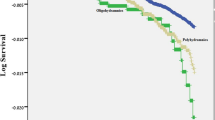Abstract
Objective
To determine the concentrations of epidermal growth factor (EGF) in amniotic fluid (AF) from women during late pregnancy, with and without pathophysiologic complications.
Methods
All AFs were collected by amniocentesis from the following groups: gestational age at least 38 weeks (n = 15); gestational age 36–37 weeks (n = 10); gestational age 35 weeks (n = 5); labor 34 weeks or less, delivered within 7 days (n = 10); labor 34 weeks or less, undelivered (n = 10); chorioamnionitis (n = 7); gestational age-matched controls (n = 7); term, in labor (n = 8); term, not in labor (n = 8); intrauterine growth restriction (IUGR) 38 weeks or more (n = 8); macrosomia at 38 weeks or more (n = 10). Epidermal growth factor was assayed using a specific radioimmunoassay.
Results
Amniotic fluid EGF levels increase rapidly in late pregnancy but are not altered by chorioamnionitis or by term or preterm labor. Intrauterine growth restriction is associated unth lower EGF levels in AF, but macrosomia is without effect.
Conclusions
Epidermal growth factor levels in AF are inaeased near term and decreased in pregnancies complicated by IUGR; they may be an indicator of specific maturational events.
Similar content being viewed by others
References
Scott SM, Buenaflor GG, Orth DN. Immunoreactive human epidermal growth factor concentrations in amniotic fluid, umbilical artery and vein serum, and placenta in full-term and preterm infants. Biol Neonate 1989;56:246–251.
Hofmann GE, Rao CV, Brown MJ, Murray LF, Schultz GS, Siddiqi TA. Epidermal growth factor in urine of nonpregnant women and pregnant women throughout pregnancy and at delivery. J Clin Endocrinol Metab 1988;66:119–23.
Hofmann GE, Abramowicz JS. Epidermal growth factor (EGF) concentrations in amniotic fluid and maternal urine during pregnancy. Acta Obstet Gynecol Scand 1990;69:217–21.
Watanabe H. Epidermal growth factor in urine of pregnant women and in amniotic fluid throughout pregnancy. Gynecol Endocrinol 1990;4:43–50.
Moharam A, Aleem F, Farmakides G, et al. Urinary and amniotic epidermal growth factor during normal and abnormal pregnancies. A comparison based upon umbilical Doppler velocimetry. Gynecol Endocrinol 1992;6:287–92.
O’Keefe E, Hollenberg MD, Cuatrecasas P. Epidermal growth factor characteristics of specific binding m membranes from liver, placenta and other target issues. Arch Biochem Biophvs 1974; 164:518–26.
Carson SA, Chase R, Ulep E, Scommegna A, Benveniste R. Ontogenesis and characteristics of epidermal growth factor receptors in human placenta. Am J Obstet Gynecol 1983;147:932–9.
Chegini N, Rao ChV. Epidermal growth factor binding to human amnion, chorion, decidua and placenta from mid- and term pregnancy: Quantitative light microscopic autoradiographic studies. J Clin Endocrinol Metab 1983;61:529–35.
Rao ChV, Carman FR Jr, Chegini N, Schultz GS. Binding sites for epidermal growth factor in human fetal membranes. J Clin Endocrinol Metab 1984;58:1034–42.
Rao ChV, Ramani R. Chegini N, et al. Topography of human placental receptors for epidermal growth factor. J Biol Chem 1985;260:1705–10.
Mitchell MD. Epidermal growth factor actions on arachidonic acid metabolism in human amnion cells. Biochim Biophys Acta 1987;98:240–2.
Casey ML, Mitchell MD, MacDonald PC. Epidermal growth factor-stimulated prostaglandin E2 production in human amnion cells: Specificity and nonesterified arachidonic acid dependency. Mol Cell Endocrinol 1987;53:169–76.
Gibbs RS, Duff P. Progress in pathogenesis and management of clinical intra-amniotic infection. Am J Obstet Gynecol 1991;164: 1317–26.
Creasy RK. Preterm labor and delivery. In: Creasy RK, Resnik R; eds. Maternal-fetal medicine: Principles and practice. WB Saunders, Philadelphia 1994:494–520.
Catterton WZ, Escobedo MB, Sexson WR, Gray ME, Sundell HW, Stahlman MT. Effect of epidermal growth factor on lung maturation in fetal rabbits. Pediatr Res 1979;13:104–8.
Goldin GV, Opperman LA. Induction of supernumerary tracheal buds and the stimulation of DNA synthesis in the embryonic chick lung and trachea by epidermal growth factor. J Embryol Exp Morp 1980;60:235–43.
Gross I, Dynia DW, Rooney SA, et al. Influence of epidermal growth factor on fetal rat lung development in vitro. Pediatr Res 1986;20:473–7.
Sundell HW, Gray ME, Seremus FS, Escobedo MB, Stahlman MT. Effects of epidermal growth factor on lung maturation in fetal lambs. Am J Pathol 1980;100:707–25.
Plopper CG, St. George JA, Read LC, et al. Acceleration of alveolar type II cell differentiation in fetal rhesus monkey lung by administration of EGF. Am J Physiol 1992;262:L313–21.
Hormann GE, Romaguera J, Williams RF, Adamsons K. Amniotic fluid epidermal growth factor concentrations. The effect of intra-amniotic thyroxine for acceleration of fetal maturation. Acta Obstet Gynecol Scand 1993;72:252–7.
Sadiq HF, Devaskar UP. Glucocorticoids increase pulmonary epidermal growth factor receptors in female and male fetal rabbit. Biochem Biophys Res Comm 1984;119:408–14.
Hofmann GE, Rao ChV, Carman FR, Siddiqi TA. 125I-human epidermal growth factor specific binding to placentas and fetal membranes from various pregnancy states. Acta Endocnnologica 1988;117:485–90.
Romero R, Wu YK, Oyarzun E, Hobbins JC, Mitchell MD. A potential role for epidermal growth factor-α-transforming growth factor in human parturition. Eur J Obstet Gynecol Re-prod Biol 1989;33:55–60.
Author information
Authors and Affiliations
Additional information
We thank the staff of the Labor and Delivery Suite at the University of Utah Medical Center for assistance with obtaining samples.
Rights and permissions
About this article
Cite this article
Varner, M.W., Dildy, G.A., Hunter, C. et al. Amniotic Fluid Epidermal Growth Factor Levels in Normal and Abnormal Pregnancies. Reprod. Sci. 3, 17–19 (1996). https://doi.org/10.1016/1071-5576(95)00044-5
Published:
Issue Date:
DOI: https://doi.org/10.1016/1071-5576(95)00044-5




